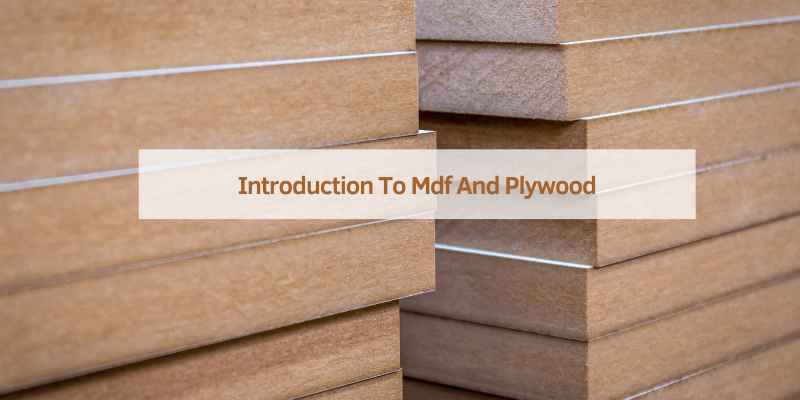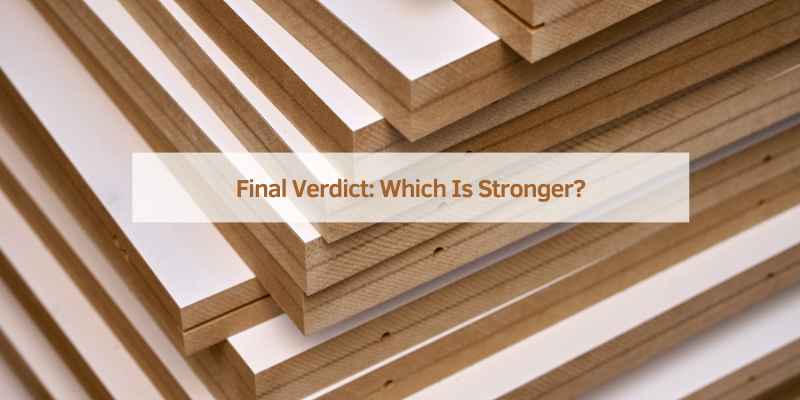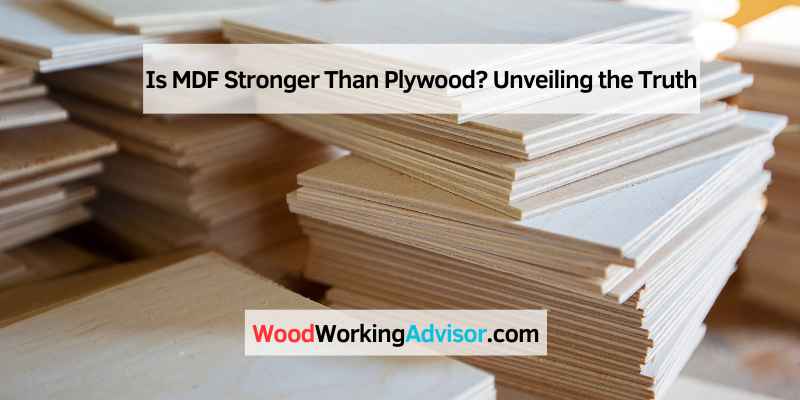MDF is not stronger than plywood. Plywood is more durable and has better structural integrity.
MDF (Medium-Density Fiberboard) and plywood are popular materials in woodworking and furniture making. MDF consists of wood fibers bonded with resin under high pressure, resulting in a smooth, dense surface. Plywood, on the other hand, is made from thin layers of wood veneer glued together, creating a strong and flexible sheet.
Plywood’s layered construction provides better resistance to warping, moisture, and impact. MDF is easier to cut and shape, making it ideal for intricate designs and interior applications. Plywood is preferred for projects requiring strength and stability. Understanding the differences helps in choosing the right material for your project needs.
Introduction To Mdf And Plywood
Choosing the right material for your project can be tricky. Both MDF and Plywood are popular choices. But what are their differences?
Material Composition
MDF stands for Medium-Density Fiberboard. It is made from wood fibers and resin. These materials are compressed under high pressure. This makes MDF dense and smooth.
Plywood is made from thin layers of wood veneer. These layers are glued together. The grain of each layer runs in different directions. This gives Plywood its strength.
Common Uses
| Material | Common Uses |
|---|---|
| MDF |
|
| Plywood |
|

Key Properties Of Mdf
Medium Density Fiberboard (MDF) is a popular material in woodworking and furniture making. Its unique properties make it a strong contender against plywood. Understanding these properties can help you make an informed decision.
Density And Strength
MDF is made from wood fibers bonded with resin under high pressure and heat. This process gives MDF a high density and consistent strength throughout. Unlike plywood, which has layers, MDF has a uniform structure. This uniformity ensures that it doesn’t have weak spots.
In terms of strength, MDF performs well in applications where it doesn’t need to bear heavy loads. It is ideal for indoor furniture, cabinets, and decorative panels. For projects requiring more strength, plywood might be the better choice.
Surface Finish
MDF has a smooth surface that is perfect for painting and veneering. Its fine texture ensures that paint adheres well, providing a flawless finish. Plywood, in contrast, may have a rougher surface, requiring more prep work.
Because of its smooth finish, MDF is often used in fine furniture and decorative projects. It allows for detailed and intricate designs without the hassle of dealing with grain patterns or knots.
Moisture Resistance
One downside of MDF is its poor moisture resistance. When exposed to water, MDF can swell and lose its structural integrity. This makes it unsuitable for outdoor use or areas with high humidity.
There are moisture-resistant grades of MDF available, but they still don’t match the durability of plywood in wet conditions. For bathroom cabinets or kitchen use, it’s essential to use a moisture-resistant variant and ensure proper sealing.
Key Properties Of Plywood
Plywood is a popular choice in construction and furniture making due to its unique properties. Understanding these properties can help in making an informed decision. Let’s delve into the key aspects that make plywood a preferred material.
Layered Structure
Plywood is made by gluing together thin layers of wood veneer. Each layer, or ply, is placed perpendicular to the adjacent one, creating a cross-grain structure. This layering process enhances the material’s strength and stability.
The number of layers can vary, usually ranging from 3 to 13 or more. More layers generally mean stronger plywood. The cross-grain technique reduces the risk of the wood splitting and ensures uniform strength across the panel.
| Number of Layers | Strength |
|---|---|
| 3-5 | Moderate |
| 6-9 | Strong |
| 10-13 | Very Strong |
Durability
Plywood is known for its durability. The cross-grain structure makes it resistant to cracking, warping, and shrinking. This property is especially useful in areas with fluctuating temperatures and humidity levels.
Different types of plywood, such as marine plywood and exterior plywood, are treated to resist moisture. This makes them suitable for outdoor use and in wet environments. Plywood also resists damage from insects and decay, adding to its long lifespan.
Flexibility
Plywood offers a high degree of flexibility, making it ideal for various applications. It can be bent into curves and shapes without breaking, unlike solid wood. This property is particularly useful in furniture design and construction.
Flexibility also allows for easier cutting and shaping, enabling intricate designs and detailed work. Plywood can be easily manipulated without losing its structural integrity.
- Can be bent into curves
- Ideal for intricate designs
- Maintains structural integrity
Comparing Strength And Durability
MDF and plywood are popular choices for furniture and building projects. But how do they compare in strength and durability? This section will explore how both materials perform under stress and in different conditions.
Stress Tests
MDF stands for Medium-Density Fiberboard. It is made from wood fibers glued together under high pressure. Plywood consists of thin layers of wood veneer glued together. Both materials are strong, but their strength comes from different structures.
MDF is dense and uniform. It does not have knots or voids. This makes it strong in all directions. Plywood has layers that make it strong in one direction. This is called grain direction. Plywood can hold screws and nails better than MDF.
| Material | Strength | Best Use |
|---|---|---|
| MDF | Uniform strength | Indoor furniture, cabinets |
| Plywood | Grain direction strength | Flooring, walls, outdoor projects |
Longevity In Various Conditions
MDF is not good with moisture. It can swell and weaken if it gets wet. Plywood is more resistant to water. It can handle moisture better than MDF.
- MDF: Best for dry, indoor conditions.
- Plywood: Suitable for both indoor and outdoor use.
Plywood is also more resistant to bending and warping. MDF is dense but can sag under heavy weight over time. This makes plywood a better option for structures needing long-term durability.
Choose MDF for smooth finishes and detailed work. Opt for plywood when strength and moisture resistance are key.
Moisture Resistance Showdown
Understanding the moisture resistance of MDF and plywood is vital. It helps in choosing the right material for your project. Let’s dive into how these materials fare under moisture exposure.
Effects Of Water Exposure
MDF swells and breaks down when exposed to water. Its structure weakens quickly. Water exposure leads to irreversible damage.
Plywood performs better against water. It retains its shape and strength. Some plywood types are even treated to resist water.
| Material | Water Resistance | Performance |
|---|---|---|
| MDF | Poor | Swells and breaks down |
| Plywood | Good | Retains shape and strength |
Suitability For Humid Environments
MDF is not suitable for humid environments. Its poor water resistance makes it a bad choice. Bathrooms and kitchens are not ideal places for MDF.
Plywood is more suitable for humid environments. Its layers of wood veneer provide better water resistance. Marine-grade plywood is specially designed for high moisture areas.
- MDF: Avoid in kitchens and bathrooms.
- Plywood: Ideal for areas with high humidity.
- Marine-grade plywood: Best for extreme moisture conditions.
Aesthetic And Finishing Differences
When choosing between MDF and plywood, the aesthetic and finishing differences play a crucial role. Both materials offer distinct advantages in terms of painting, staining, and visual appeal. Understanding these differences helps in making an informed decision for your project.
Painting And Staining
MDF has a smooth surface, which makes it ideal for painting. The lack of wood grain means you get a consistent, even coat. This material absorbs paint well, giving a professional finish without much effort.
On the other hand, plywood presents a more natural wood look. It features wood grain patterns, which can be enhanced with staining. Plywood can also be painted, but the natural texture might still show through.
| Material | Painting | Staining |
|---|---|---|
| MDF | Excellent | Not Ideal |
| Plywood | Good | Excellent |
Visual Appeal
Visual appeal is another key factor. MDF provides a sleek, modern look because of its smooth finish. It is perfect for contemporary designs where a flawless surface is desired. MDF can also be easily customized with intricate designs and patterns.
Plywood, with its natural wood grain, offers a more rustic and traditional appearance. This makes it suitable for projects where a natural look is preferred. Plywood’s grain patterns can vary, adding a unique touch to each piece.
- MDF: Smooth, sleek, modern
- Plywood: Natural, rustic, unique grain patterns
In summary, the choice between MDF and plywood depends on the desired aesthetic and the type of finish you want to achieve.
Cost Considerations
When deciding between MDF and plywood for your project, understanding the cost differences is crucial. Both materials have unique strengths, but their prices and value propositions vary. This section explores the cost considerations to help you make an informed choice.
Price Comparison
MDF (Medium Density Fiberboard) is often cheaper than plywood. This lower cost makes MDF a popular choice for budget-conscious projects.
On the other hand, plywood tends to be more expensive. The cost varies based on the type, grade, and thickness of the plywood. High-quality plywood can be significantly pricier than MDF.
| Material | Average Cost per Sheet (4×8 ft) |
|---|---|
| MDF | $20 – $30 |
| Plywood | $30 – $60 |
Value For Money
While MDF is cheaper, plywood offers greater durability and strength. This makes plywood a better long-term investment for many projects.
For furniture or cabinetry, plywood’s resistance to moisture and warping provides better value. MDF, despite its lower cost, may require more frequent replacements, potentially increasing overall expenses.
Assessing your project needs and budget is essential. Investing in plywood might save money in the long run, thanks to its superior strength and durability.
- Short-term savings: MDF is budget-friendly upfront.
- Long-term investment: Plywood offers better longevity.
- Evaluate project requirements.
- Consider budget constraints.
- Weigh short-term vs. long-term benefits.
Practical Applications In Construction And Design
Both MDF (Medium-Density Fiberboard) and plywood are popular materials in construction and design. Each has unique properties that make them suitable for different applications. Understanding their strengths helps in choosing the right material for the project.
Furniture Making
MDF is widely used in furniture making due to its smooth surface and ease of painting. It is ideal for making cabinet doors, shelves, and decorative pieces. MDF’s consistency ensures a uniform finish on all pieces.
Plywood is favored for furniture that requires durability. Its layered structure makes it more resistant to warping and suitable for items that bear weight. Plywood is often used in chairs, tables, and sofas.
Interior Design
In interior design, both MDF and plywood have significant roles. MDF is often used for moldings and trims due to its smooth edges and ease of cutting. It can be shaped into various designs, making it perfect for detailed architectural elements.
Plywood is suitable for wall panels and flooring. Its strong and stable nature makes it ideal for areas with high traffic. Plywood’s natural wood grain adds a rustic charm to interiors.
Structural Uses
For structural applications, plywood is often the material of choice. Its strength and flexibility make it suitable for roofing, subflooring, and wall sheathing. Plywood’s ability to withstand heavy loads makes it reliable for construction.
MDF is less common in structural uses due to its density. It can be used for non-load-bearing walls and partitions. MDF is also used in soundproofing applications because of its density and uniformity.
Here is a comparison table for quick reference:
| Application | MDF | Plywood |
|---|---|---|
| Furniture Making | Cabinet doors, shelves, decorative pieces | Chairs, tables, sofas |
| Interior Design | Moldings, trims | Wall panels, flooring |
| Structural Uses | Non-load-bearing walls, partitions | Roofing, subflooring, wall sheathing |
Choosing between MDF and plywood depends on the specific needs of the project. Each material offers unique benefits that cater to different aspects of construction and design.
Environmental Impact And Sustainability
The environmental impact and sustainability of materials are important considerations. Both MDF (Medium-Density Fiberboard) and plywood have their own pros and cons. Understanding these can help you make a better choice for your projects.
Sourcing Materials
MDF is made from wood fibers, which are often recycled. These fibers are bonded with resin and wax. The wood used in MDF production can come from fast-growing trees. This helps reduce deforestation of older forests.
Plywood, on the other hand, is made by gluing together thin layers of wood veneer. These veneers come from logs, which are peeled into thin sheets. The wood for plywood often comes from slow-growing trees. This can impact old-growth forests more than MDF.
Recyclability
Both MDF and plywood can be recycled, but there are differences. MDF is harder to recycle because of the resin and wax used. These chemicals make it difficult to break down and reuse the fibers.
Plywood is easier to recycle. The layers can be separated and reused in various ways. This makes plywood a more sustainable choice for those concerned with recyclability.
Environmental Impact Comparison
| Factor | MDF | Plywood |
|---|---|---|
| Source Materials | Recycled wood fibers | Logs from trees |
| Tree Impact | Uses fast-growing trees | Uses slow-growing trees |
| Recyclability | Harder to recycle | Easier to recycle |
By considering the sourcing and recyclability of MDF and plywood, you can make an informed choice for your projects. Choose the material that aligns with your values and environmental goals.
Final Verdict: Which Is Stronger?
When comparing the strength of MDF and plywood, it’s important to note that both materials have their unique advantages. MDF (Medium Density Fiberboard) is made from wood fibers glued together under heat and pressure. This makes MDF smooth and consistent in texture. Plywood, on the other hand, consists of thin layers of wood veneer glued together. This layered construction gives plywood its strength and flexibility.
| Criteria | MDF | Plywood |
|---|---|---|
| Strength | Less durable | More durable |
| Weight | Heavier | Lighter |
| Cost | Less expensive | More expensive |
| Moisture Resistance | Low | High |
Application-specific Recommendations
For furniture making, MDF is often preferred because of its smooth surface. It is easy to paint and finish. Cabinets and shelves made from MDF look sleek. Plywood is a better choice for outdoor furniture. It resists moisture and withstands harsh weather conditions.
In construction, plywood is the go-to material. It is used for subfloors, roofing, and walls. Plywood’s layered construction provides excellent strength. MDF is rarely used in structural applications. It lacks the strength needed for heavy loads.
Making The Right Choice For Your Project
Consider the environment where the material will be used. For humid conditions, plywood is the better option. MDF absorbs moisture quickly. For detailed work, MDF is ideal. It can be cut and shaped easily.
- Budget: MDF is more affordable.
- Strength needs: Choose plywood for high strength.
- Finish: MDF offers a smooth finish for painting.
Remember to weigh the pros and cons of each material. Your project requirements will guide the best choice. Both MDF and plywood have their strengths. Use them wisely to achieve the best results.

Frequently Asked Questions
Why Use Mdf Instead Of Plywood?
MDF is smoother and easier to paint than plywood. It offers a uniform surface without knots. MDF is also more affordable.
What Are The Disadvantages Of Mdf?
MDF is less durable than solid wood. It can swell and warp from moisture. MDF produces harmful dust when cut.
When Should You Not Use Mdf?
Avoid using MDF in high-moisture areas like bathrooms and kitchens. It swells and deteriorates when exposed to water. MDF isn’t suitable for heavy-load bearing structures. It can release formaldehyde, making it a poor choice for enclosed spaces without proper ventilation.
Can Mdf Hold Weight?
Yes, MDF can hold weight but it depends on thickness and support. Use proper brackets and screws for stability.
Conclusion
Choosing between MDF and plywood depends on your project needs. MDF offers a smooth finish, ideal for painting. Plywood provides superior strength and durability, perfect for structural work. Each material has its own advantages. Evaluate your specific requirements to make the best choice.
Both options can deliver excellent results in the right context.


